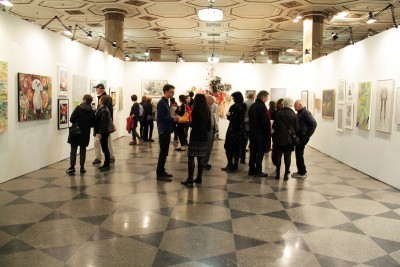
With galleries, studios and concert venues scattered across Boston University’s campus, the city of Boston has been named a top cultural and artistic hub, according to the Arts Vibrancy Index report by the National Center for Arts Research, released Jan. 21.
Lynne Allen, the director of the College of Fine Art’s School of Visual Arts, said students and faculty at BU can contribute to a vibrant arts community both on campus and in the city. Events such as the School of Visual Arts’ Faculty Exhibition, opening Friday, give members of the school art community opportunities to display their work.
“We [BU] contribute through relationships with many non-profit arts organizations, by hosting music events, master classes, visiting artist lectures open and free to the public, art exhibitions of professional artists from around the world, plus we are educating the next generation of art professionals and leaders,” she said in an email.
The “Boston, MA, Metro Division,” as it was called in the report, ranked fourth out of 20 large cities nationwide, and included Norfolk, Plymouth and Suffolk Counties. Boston was trumped only by the Washington-Arlington-Alexandria area, ranked number one, the Nashville-Davidson-Murfreesboro-Franklin area, ranked number two, and the New York-Jersey City-White Plains area, ranked number three.
Ty Furman, the managing director for BU’s Arts Initiative, said BU contributes to the culture of the city in distinct ways by providing education, training and experience through programs offered through CFA, the College of Communication and the College of Arts and Sciences.
“As a relative newcomer to Boston, I can only say what I have seen and experienced and that is the energy, commitment and enthusiasm around how city government can affect change in the arts sector,” he said in an email. “It is a great time to be an artist in Boston, and our office is committed to continuing to participate in city-wide dialogue around these issues and providing increased access and support for our students to engage with the arts both on and off campus.”
Boston’s large student population and the presence of art institutions contribute to Boston’s classification as an artistic hub, Furman said.
“The Boston area not only has more colleges and universities than any other U.S. region, it boasts some of the best arts training programs in the U.S. including those at Boston University,” he said. “There are several arts service organizations that … provide invaluable resources to large and small arts organizations and provide countless opportunities for artists and arts administrators to come together whether in celebration or for advocacy.”
Meg Tyler, a professor of humanities in the College of General Studies said the arts initiative leads a concerted effort for the university to maintain the artistic presence in an “art-rich environment.”
“We have so many young people coming in and out of the city who are inspired to make their mark and try something new,” she said. “We have such a variety of educational institutions, which impress upon those young people the wealth of the western tradition so they learn about the tradition. They try to perceive their place in it, and then they want to try to do something a little bit new or some kind of mixture of what people have done.”
Tyler said the increasing presence of technology and the high entrance cost into many institutions affects the city’s cultural and artistic environment and the ways in which art is experienced.
“The problem is, there are so many distractions in the city, and I worry a little bit about the addictiveness of screens. I fall prey to that myself,” she said. “It’s harder to drag people away from their machines now. You have some exhibitions online, but it’s really not the same as seeing it in person.”
Several CFA students said they found value in their arts education and the relationships they’ve made as a result of their hard work and time spent at CFA.
Michelle Pizzo, a senior in CFA, will soon have her work, along with the work of one of her classmates, featured in an upcoming gallery show called “Flu-Like Symptoms,” which premieres on Feb. 25.
“It’s a show of paintings and mixed media pieces,” she said. “Some of the themes are the obscurity of meaning and emotions, collaging imagery and ideas. The title is basically a joke about art school and how 90 percent of the time, it feels like getting sick.”
Kelly McCabe, a senior in CFA, said she appreciates the shows throughout the year that allow other students to see her work and allow her to see her classmates’ work.
“I like that BU has a student-run gallery and gives us the opportunity to have a thesis show in 808 [Gallery]. The thesis show is a final undergrad senior show, which will be up around April and May. It’s a culmination of all of our work,” she said. “The alumni show was just up, but is now taken down, and that had alumni from all over the world and of different graduation years.”
Julianna Hoff, a sophomore in CFA’s five-year Art Education Masters Program, said CFA is a community of artists and has an atmosphere of growth and learning.
“Being in both studio and art education courses, I can really see how the whole of CFA puts being an artist first and foremost,” she said. “Both professors and students are pretty invested in their own work.”























































































































